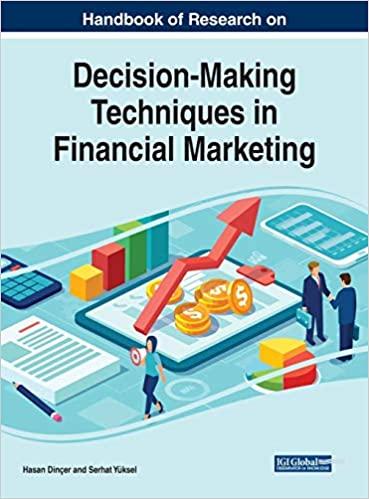With the help of the case State Fair of Virginia, answer the following questions:
- What caused State Fair of Virginia to be in its current precarious financial condition?
- Who are the parties impacted by State Fair of Virginia's financial challenges? What is the magnitude of the harm to these parties?
- Evaluate the options before the Board. Are there any other actions they could take?
- What steps should be taken by the State Fair of Virginia Board of Directors?
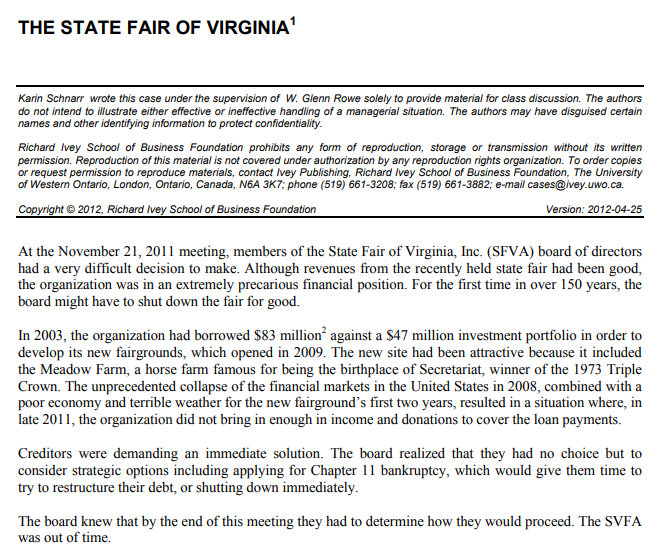
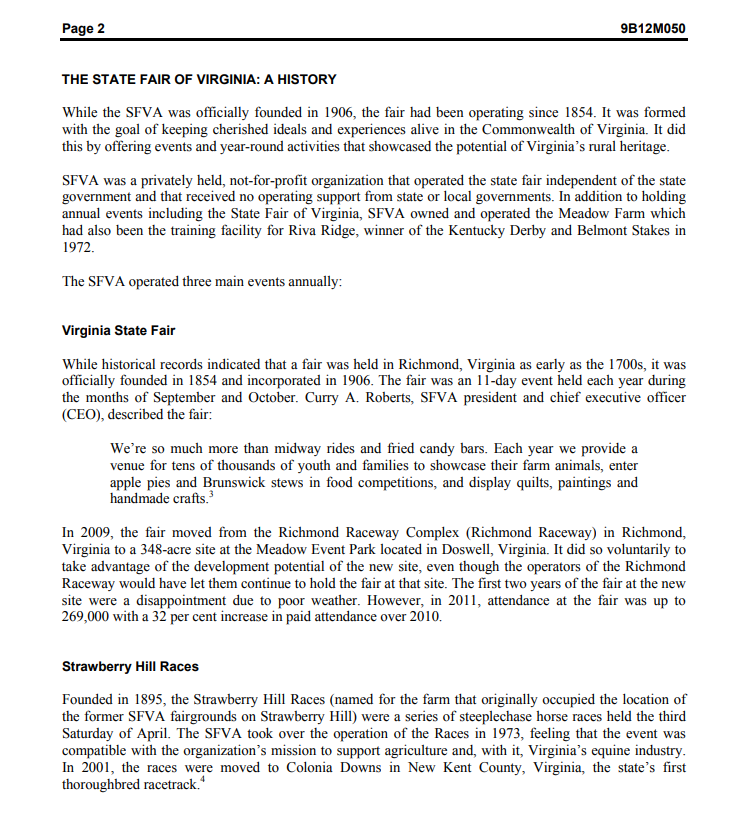
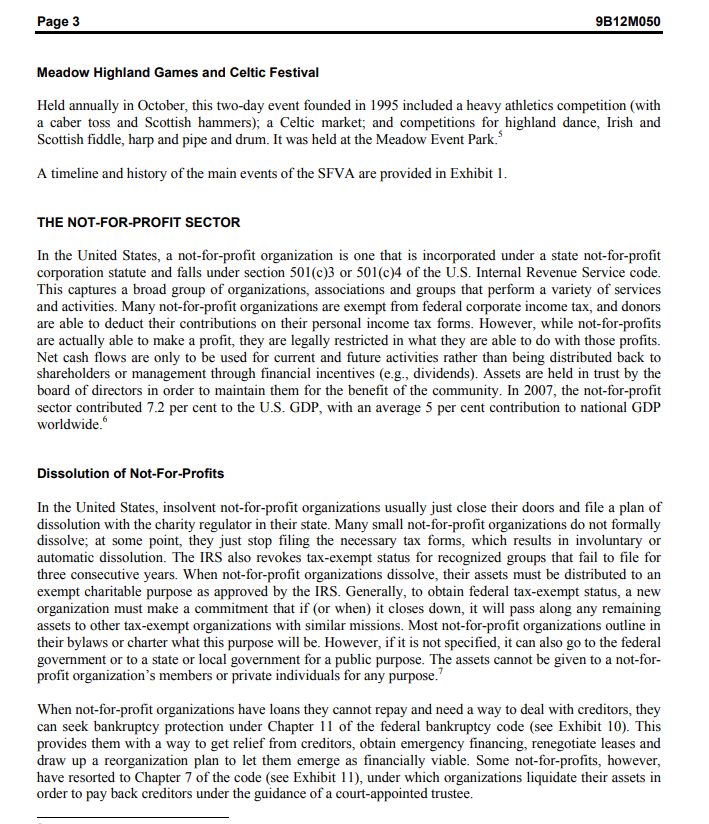
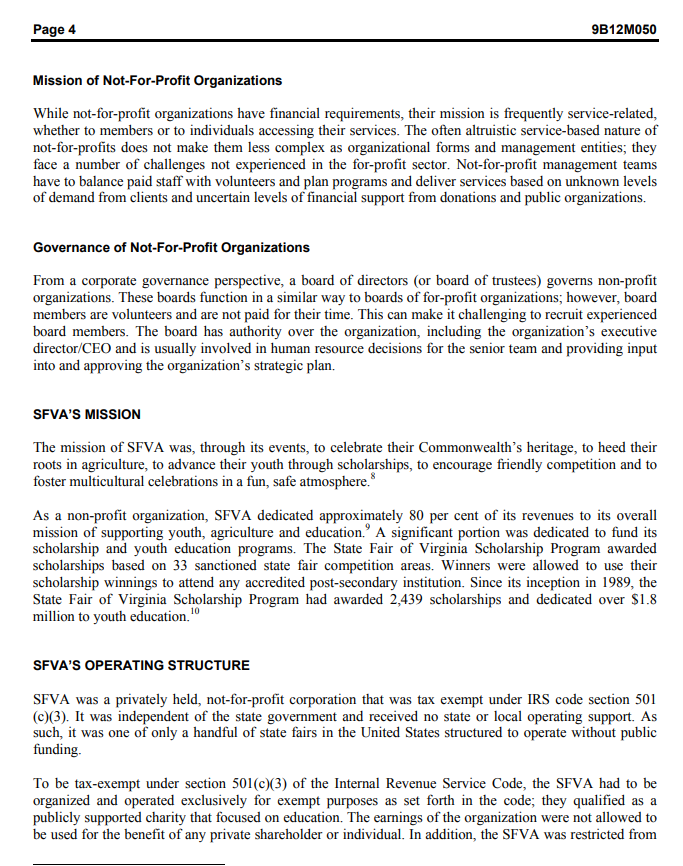
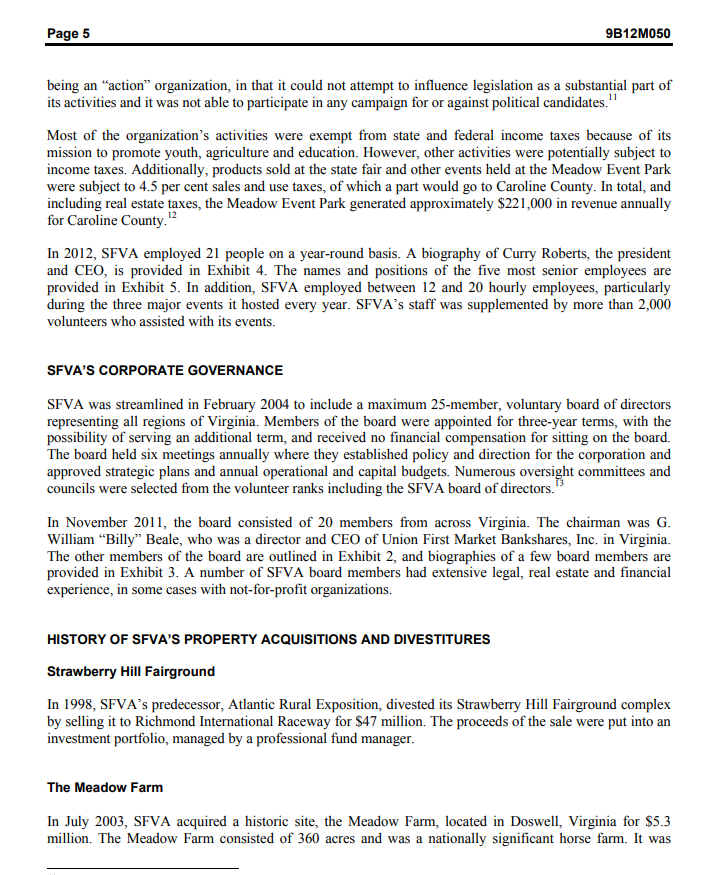
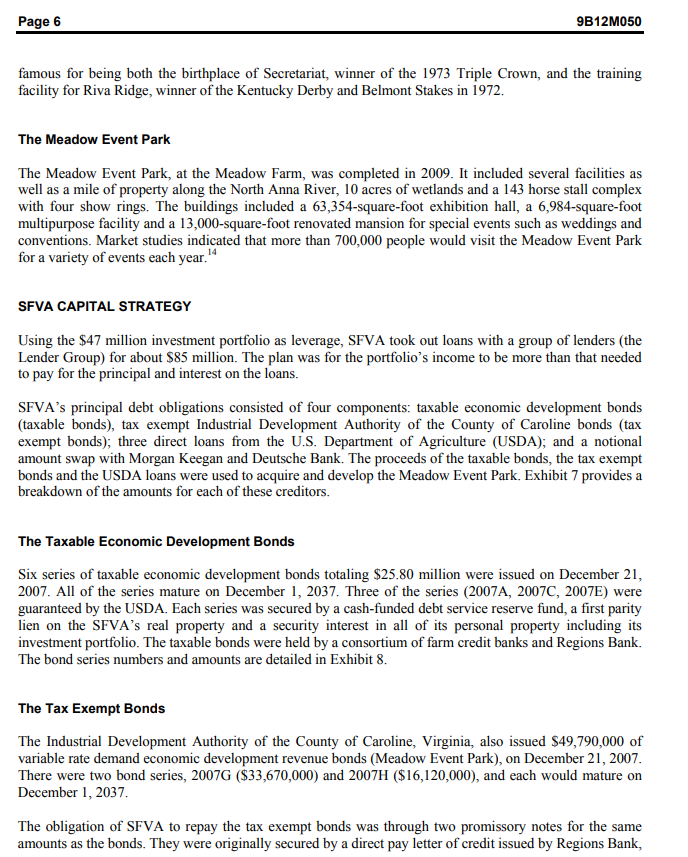
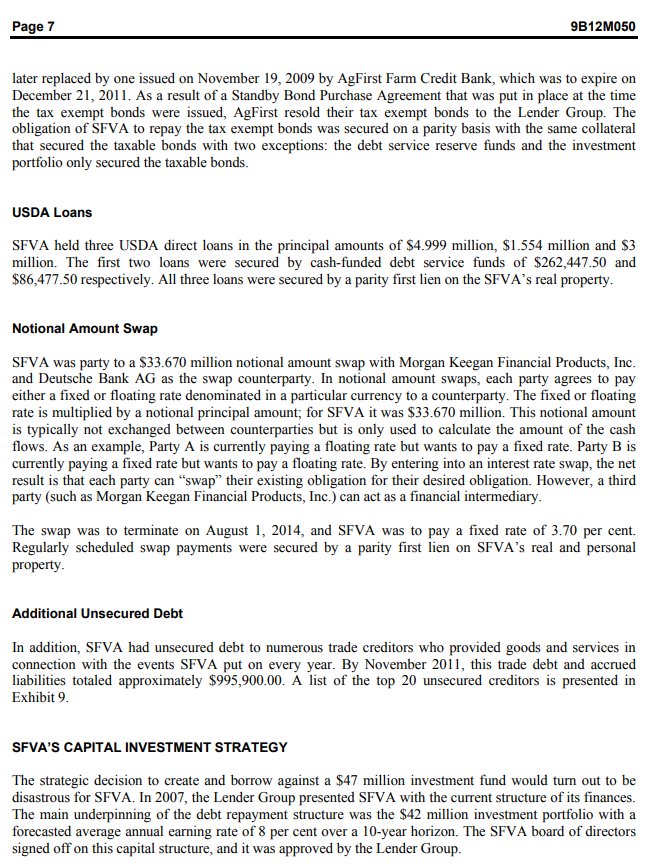
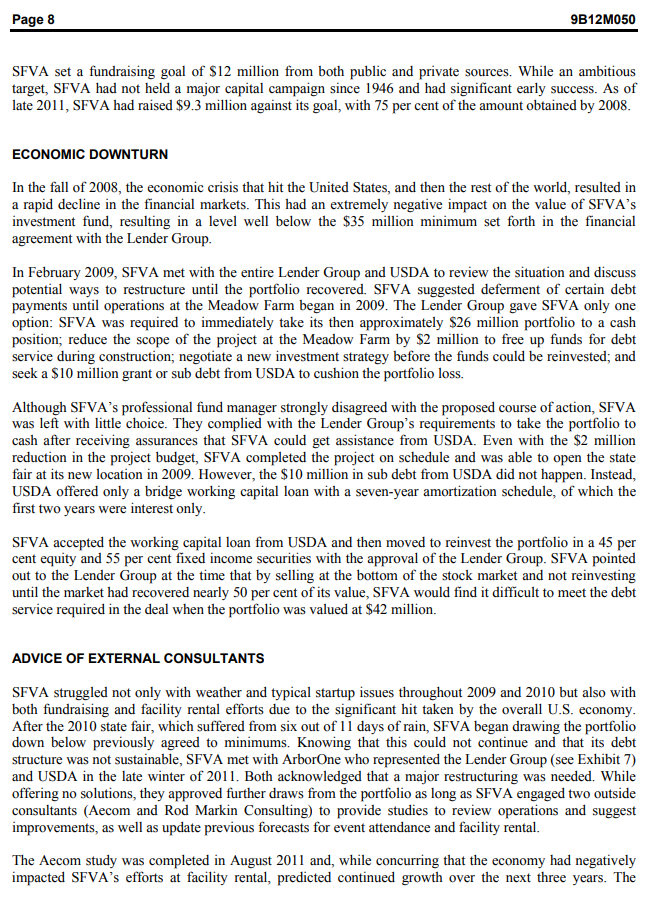
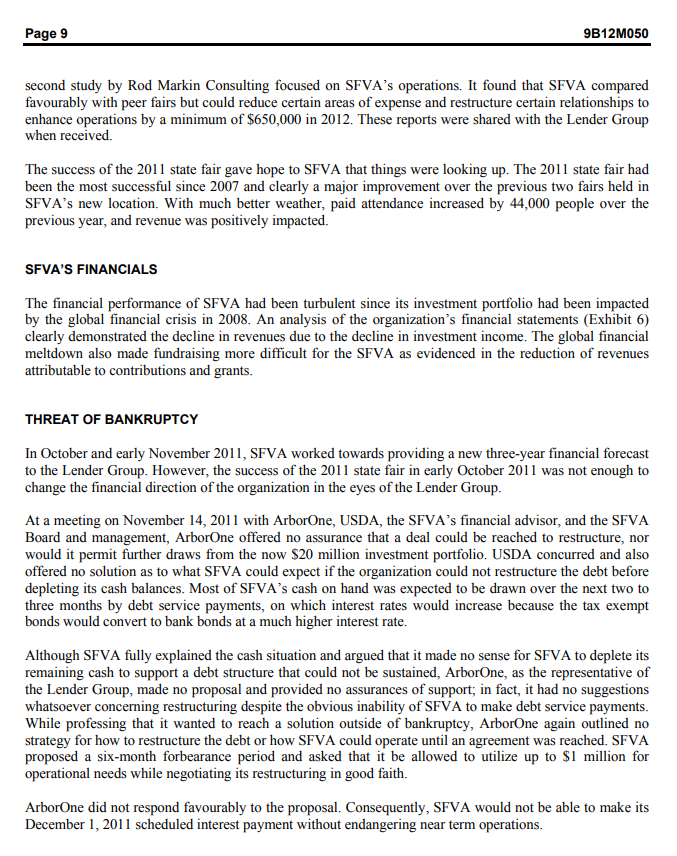
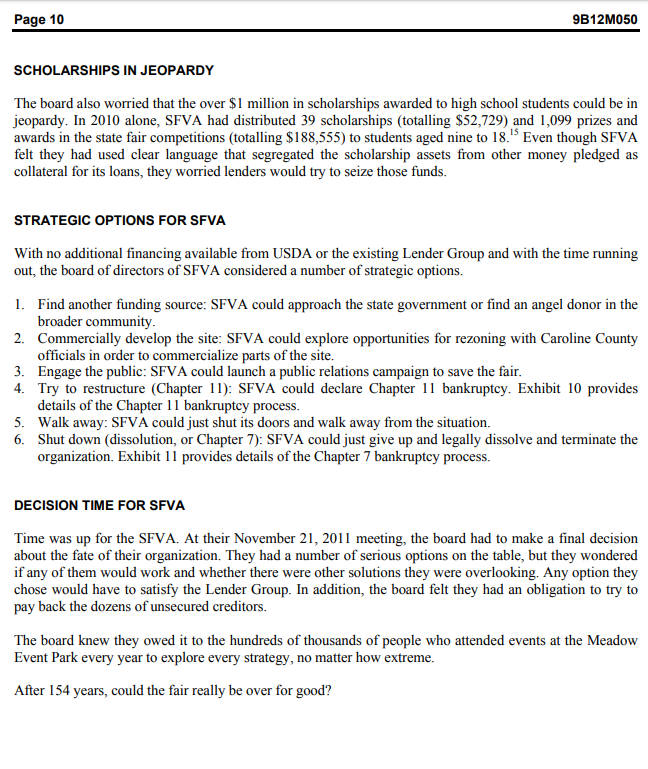
THE STATE FAIR OF VIRGINIA Karin Schnarr wrote this case under the supervision of W. Glenn Rowe solely to provide material for class discussion. The authors do not intend to illustrate either effective or ineffective handling of a managerial situation. The authors may have disguised certain names and other identifying information to protect confidentiality Richard Ivey School of Business Foundation prohibits any form of reproduction, storage or transmission without its written permission. Reproduction of this material is not covered under authorization by any reproduction rights organization. To order copies or request permission to reproduce materials, contact Ivey Publishing, Richard Ivey School of Business Foundation, The University of Western Ontario, London, Ontario, Canada, N6A 3K7, phone (519) 661-3208, fax (519) 661-3882, e-mail cases@ivey.uwo.ca. Copyright 2012. Richard Ivey School of Business Foundation Version: 2012-04-25 At the November 21, 2011 meeting, members of the State Fair of Virginia, Inc. (SFVA) board of directors had a very difficult decision to make. Although revenues from the recently held state fair had been good, the organization was in an extremely precarious financial position. For the first time in over 150 years, the board might have to shut down the fair for good. In 2003, the organization had borrowed $83 million against a $47 million investment portfolio in order to develop its new fairgrounds, which opened in 2009. The new site had been attractive because it included the Meadow Farm, a horse farm famous for being the birthplace of Secretariat, winner of the 1973 Triple Crown. The unprecedented collapse of the financial markets in the United States in 2008, combined with a poor economy and terrible weather for the new fairground's first two years, resulted in a situation where, in late 2011, the organization did not bring in enough in income and donations to cover the loan payments. Creditors were demanding an immediate solution. The board realized that they had no choice but to consider strategic options including applying for Chapter 11 bankruptcy, which would give them time to try to restructure their debt, or shutting down immediately. The board knew that by the end of this meeting they had to determine how they would proceed. The SVFA was out of time. Page 2 9B12M050 THE STATE FAIR OF VIRGINIA: A HISTORY While the SFVA was officially founded in 1906, the fair had been operating since 1854. It was formed with the goal of keeping cherished ideals and experiences alive in the Commonwealth of Virginia. It did this by offering events and year-round activities that showcased the potential of Virginia's rural heritage. SFVA was a privately held, not-for-profit organization that operated the state fair independent of the state government and that received no operating support from state or local governments. In addition to holding annual events including the State Fair of Virginia, SFVA owned and operated the Meadow Farm which had also been the training facility for Riva Ridge, winner of the Kentucky Derby and Belmont Stakes in 1972. The SFVA operated three main events annually: Virginia State Fair While historical records indicated that a fair was held in Richmond, Virginia as early as the 1700s, it was officially founded in 1854 and incorporated in 1906. The fair was an 11-day event held each year during the months of September and October. Curry A. Roberts, SFVA president and chief executive officer (CEO), described the fair: We're so much more than midway rides and fried candy bars. Each year we provide a venue for tens of thousands of youth and families to showcase their farm animals, enter apple pies and Brunswick stews in food competitions, and display quilts, paintings and handmade crafts. In 2009, the fair moved from the Richmond Raceway Complex (Richmond Raceway) in Richmond, Virginia to a 348-acre site at the Meadow Event Park located in Doswell, Virginia. It did so voluntarily to take advantage of the development potential of the new site, even though the operators of the Richmond Raceway would have let them continue to hold the fair at that site. The first two years of the fair at the new site were a disappointment due to poor weather. However, in 2011, attendance at the fair was up to 269,000 with a 32 per cent increase in paid attendance over 2010. Strawberry Hill Races Founded in 1895, the Strawberry Hill Races (named for the farm that originally occupied the location of the former SFVA fairgrounds on Strawberry Hill) were a series of steeplechase horse races held the third Saturday of April. The SFVA took over the operation of the Races in 1973, feeling that the event was compatible with the organization's mission to support agriculture and, with it, Virginia's equine industry, In 2001, the races were moved to Colonia Downs in New Kent County, Virginia, the state's first thoroughbred racetrack. Page 3 9B12M050 Meadow Highland Games and Celtic Festival Held annually in October, this two-day event founded in 1995 included a heavy athletics competition (with a caber toss and Scottish hammers), a Celtic market, and competitions for highland dance, Irish and Scottish fiddle, harp and pipe and drum. It was held at the Meadow Event Park." A timeline and history of the main events of the SFVA are provided in Exhibit 1. THE NOT-FOR-PROFIT SECTOR In the United States, a not-for-profit organization is one that is incorporated under a state not-for-profit corporation statute and falls under section 501(C)3 or 501(c)4 of the U.S. Internal Revenue Service code. This captures a broad group of organizations, associations and groups that perform a variety of services and activities. Many not-for-profit organizations are exempt from federal corporate income tax, and donors are able to deduct their contributions on their personal income tax forms. However, while not-for-profits are actually able to make a profit, they are legally restricted in what they are able to do with those profits. Net cash flows are only to be used for current and future activities rather than being distributed back to shareholders or management through financial incentives (e.g., dividends). Assets are held in trust by the board of directors in order to maintain them for the benefit of the community. In 2007, the not-for-profit sector contributed 7.2 per cent to the U.S. GDP, with an average 5 per cent contribution to national GDP worldwide. Dissolution of Not-For-Profits In the United States, insolvent not-for-profit organizations usually just close their doors and file a plan of dissolution with the charity regulator in their state. Many small not-for-profit organizations do not formally dissolve; at some point, they just stop filing the necessary tax forms, which results in involuntary or automatic dissolution. The IRS also revokes tax-exempt status for recognized groups that fail to file for three consecutive years. When not-for-profit organizations dissolve, their assets must be distributed to an exempt charitable purpose as approved by the IRS. Generally, to obtain federal tax-exempt status, a new organization must make a commitment that if (or when) it closes down, it will pass along any remaining assets to other tax-exempt organizations with similar missions. Most not-for-profit organizations outline in their bylaws or charter what this purpose will be. However, if it is not specified, it can also go to the federal government or to a state or local government for a public purpose. The assets cannot be given to a not-for- profit organization's members or private individuals for any purpose." When not-for-profit organizations have loans they cannot repay and need a way to deal with creditors, they can seek bankruptcy protection under Chapter 11 of the federal bankruptcy code (see Exhibit 10). This provides them with a way to get relief from creditors, obtain emergency financing, renegotiate leases and draw up a reorganization plan to let them emerge as financially viable. Some not-for-profits, however, have resorted to Chapter 7 of the code (see Exhibit 11), under which organizations liquidate their assets in order to pay back creditors under the guidance of a court-appointed trustee. Page 4 9B12M050 Mission of Not-For-Profit Organizations While not-for-profit organizations have financial requirements, their mission is frequently service-related, whether to members or to individuals accessing their services. The often altruistic service-based nature of not-for-profits does not make them less complex as organizational forms and management entities; they face a number of challenges not experienced in the for-profit sector. Not-for-profit management teams have to balance paid staff with volunteers and plan programs and deliver services based on unknown levels of demand from clients and uncertain levels of financial support from donations and public organizations. Governance of Not-For-Profit Organizations From a corporate governance perspective, a board of directors (or board of trustees) governs non-profit organizations. These boards function in a similar way to boards of for-profit organizations, however, board members are volunteers and are not paid for their time. This can make it challenging to recruit experienced board members. The board has authority over the organization, including the organization's executive director/CEO and is usually involved in human resource decisions for the senior team and providing input into and approving the organization's strategic plan. SFVA'S MISSION The mission of SFVA was, through its events, to celebrate their Commonwealth's heritage, to heed their roots in agriculture, to advance their youth through scholarships, to encourage friendly competition and to foster multicultural celebrations in a fun, safe atmosphere. As a non-profit organization, SFVA dedicated approximately 80 per cent of its revenues to its overall mission of supporting youth, agriculture and education. A significant portion was dedicated to fund its scholarship and youth education programs. The State Fair of Virginia Scholarship Program awarded scholarships based on 33 sanctioned state fair competition areas. Winners were allowed to use their scholarship winnings to attend any accredited post-secondary institution. Since its inception in 1989, the State Fair of Virginia Scholarship Program had awarded 2,439 scholarships and dedicated over $1.8 million to youth education." SFVA'S OPERATING STRUCTURE SFVA was a privately held, not-for-profit corporation that was tax exempt under IRS code section 501 (c)(3). It was independent of the state government and received no state or local operating support. As such, it was one of only a handful of state fairs in the United States structured to operate without public funding To be tax-exempt under section 501(c)(3) of the Internal Revenue Service Code, the SFVA had to be organized and operated exclusively for exempt purposes as set forth in the code; they qualified as a publicly supported charity that focused on education. The earnings of the organization were not allowed to be used for the benefit of any private shareholder or individual. In addition, the SFVA was restricted from Page 5 9B12M050 being an "action" organization, in that it could not attempt to influence legislation as a substantial part of its activities and it was not able to participate in any campaign for or against political candidates." Most of the organization's activities were exempt from state and federal income taxes because of its mission to promote youth, agriculture and education. However, other activities were potentially subject to income taxes. Additionally, products sold at the state fair and other events held at the Meadow Event Park were subject to 4.5 per cent sales and use taxes, of which a part would go to Caroline County. In total, and including real estate taxes, the Meadow Event Park generated approximately $221,000 in revenue annually for Caroline County." In 2012, SFVA employed 21 people on a year-round basis. A biography of Curry Roberts, the president and CEO, is provided in Exhibit 4. The names and positions of the five most senior employees are provided in Exhibit 5. In addition, SFVA employed between 12 and 20 hourly employees, particularly during the three major events it hosted every year. SFVA's staff was supplemented by more than 2,000 volunteers who assisted with its events. SFVA'S CORPORATE GOVERNANCE SFVA was streamlined in February 2004 to include a maximum 25-member, voluntary board of directors representing all regions of Virginia. Members of the board were appointed for three-year terms, with the possibility of serving an additional term, and received no financial compensation for sitting on the board. The board held six meetings annually where they established policy and direction for the corporation and approved strategic plans and annual operational and capital budgets. Numerous oversight committees and councils were selected from the volunteer ranks including the SFVA board of directors." In November 2011, the board consisted of 20 members from across Virginia. The chairman was G. William "Billy" Beale, who was a director and CEO of Union First Market Bankshares, Inc. in Virginia. The other members of the board are outlined in Exhibit 2, and biographies of a few board members are provided in Exhibit 3. A number of SFVA board members had extensive legal, real estate and financial experience, in some cases with not-for-profit organizations. HISTORY OF SFVA'S PROPERTY ACQUISITIONS AND DIVESTITURES Strawberry Hill Fairground In 1998, SFVA's predecessor, Atlantic Rural Exposition, divested its Strawberry Hill Fairground complex by selling it to Richmond International Raceway for $47 million. The proceeds of the sale were put into an investment portfolio, managed by a professional fund manager The Meadow Farm In July 2003, SFVA acquired a historic site, the Meadow Farm, located in Doswell, Virginia for $5.3 million. The Meadow Farm consisted of 360 acres and was a nationally significant horse farm. It was Page 6 9B12M050 famous for being both the birthplace of Secretariat, winner of the 1973 Triple Crown, and the training facility for Riva Ridge, winner of the Kentucky Derby and Belmont Stakes in 1972. The Meadow Event Park The Meadow Event Park, at the Meadow Farm, was completed in 2009. It included several facilities as well as a mile of property along the North Anna River, 10 acres of wetlands and a 143 horse stall complex with four show rings. The buildings included a 63,354-square-foot exhibition hall, a 6,984-square-foot multipurpose facility and a 13,000-square-foot renovated mansion for special events such as weddings and conventions. Market studies indicated that more than 700,000 people would visit the Meadow Event Park for a variety of events each year." SFVA CAPITAL STRATEGY Using the $47 million investment portfolio as leverage, SFVA took out loans with a group of lenders (the Lender Group) for about $85 million. The plan was for the portfolio's income to be more than that needed to pay for the principal and interest on the loans. SFVA's principal debt obligations consisted of four components: taxable economic development bonds (taxable bonds), tax exempt Industrial Development Authority of the County of Caroline bonds (tax exempt bonds); three direct loans from the U.S. Department of Agriculture (USDA); and a notional amount swap with Morgan Keegan and Deutsche Bank. The proceeds of the taxable bonds, the tax exempt bonds and the USDA loans were used to acquire and develop the Meadow Event Park, Exhibit 7 provides a breakdown of the amounts for each of these creditors. The Taxable Economic Development Bonds Six series of taxable economic development bonds totaling $25.80 million were issued on December 21, 2007. All of the series mature on December 1, 2037. Three of the series (2007A, 2007C, 2007E) were guaranteed by the USDA. Each series was secured by a cash-funded debt service reserve fund, a first parity lien on the SFVA's real property and a security interest in all of its personal property including its investment portfolio. The taxable bonds were held by a consortium of farm credit banks and Regions Bank. The bond series numbers and amounts are detailed in Exhibit 8. The Tax Exempt Bonds The Industrial Development Authority of the County of Caroline, Virginia, also issued $49,790,000 of variable rate demand economic development revenue bonds (Meadow Event Park), on December 21, 2007. There were two bond series, 2007G ($33,670,000) and 2007H ($16,120,000), and each would mature on December 1, 2037. The obligation of SFVA to repay the tax exempt bonds was through two promissory notes for the same amounts as the bonds. They were originally secured by a direct pay letter of credit issued by Regions Bank, Page 7 9B12M050 later replaced by one issued on November 19, 2009 by AgFirst Farm Credit Bank, which was to expire on December 21, 2011. As a result of a Standby Bond Purchase Agreement that was put in place at the time the tax exempt bonds were issued, AgFirst resold their tax exempt bonds to the Lender Group. The obligation of SFVA to repay the tax exempt bonds was secured on a parity basis with the same collateral that secured the taxable bonds with two exceptions: the debt service reserve funds and the investment portfolio only secured the taxable bonds. USDA Loans SFVA held three USDA direct loans in the principal amounts of $4.999 million, $1.554 million and $3 million. The first two loans were secured by cash-funded debt service funds of $262,447.50 and $86,477.50 respectively. All three loans were secured by a parity first lien on the SFVA's real property. Notional Amount Swap SFVA was party to a $33.670 million notional amount swap with Morgan Keegan Financial Products, Inc. and Deutsche Bank AG as the swap counterparty. In notional amount swaps, each party agrees to pay either a fixed or floating rate denominated in a particular currency to a counterparty. The fixed or floating rate is multiplied by a notional principal amount; for SFVA it was $33.670 million. This notional amount is typically not exchanged between counterparties but is only used to calculate the amount of the cash flows. As an example, Party A is currently paying a floating rate but wants to pay a fixed rate. Party B is currently paying a fixed rate but wants to pay a floating rate. By entering into an interest rate swap, the net result is that each party can swap their existing obligation for their desired obligation. However, a third party (such as Morgan Keegan Financial Products, Inc.) can act as a financial intermediary. The swap was to terminate on August 1, 2014, and SFVA was to pay a fixed rate of 3.70 per cent. Regularly scheduled swap payments were secured by a parity first lien on SFVA's real and personal property. Additional Unsecured Debt In addition, SFVA had unsecured debt to numerous trade creditors who provided goods and services in connection with the events SFVA put on every year. By November 2011, this trade debt and accrued liabilities totaled approximately $995,900.00. A list of the top 20 unsecured creditors is presented in Exhibit 9. SFVA'S CAPITAL INVESTMENT STRATEGY The strategic decision to create and borrow against a $47 million investment fund would turn out to be disastrous for SFVA. In 2007, the Lender Group presented SFVA with the current structure of its finances. The main underpinning of the debt repayment structure was the $42 million investment portfolio with a forecasted average annual earning rate of 8 per cent over a 10-year horizon. The SFVA board of directors signed off on this capital structure, and it was approved by the Lender Group. Page 8 9B12M050 SFVA set a fundraising goal of $12 million from both public and private sources. While an ambitious target, SFVA had not held a major capital campaign since 1946 and had significant early success. As of late 2011, SFVA had raised $9.3 million against its goal, with 75 per cent of the amount obtained by 2008. ECONOMIC DOWNTURN In the fall of 2008, the economic crisis that hit the United States, and then the rest of the world, resulted in a rapid decline in the financial markets. This had an extremely negative impact on the value of SFVA's investment fund, resulting in a level well below the $35 million minimum set forth in the financial agreement with the Lender Group. In February 2009, SFVA met with the entire Lender Group and USDA to review the situation and discuss potential ways to restructure until the portfolio recovered. SFVA suggested deferment of certain debt payments until operations at the Meadow Farm began in 2009. The Lender Group gave SFVA only one option: SFVA was required to immediately take its then approximately $26 million portfolio to a cash position; reduce the scope of the project at the Meadow Farm by $2 million to free up funds for debt service during construction, negotiate a new investment strategy before the funds could be reinvested; and seek a $10 million grant or sub debt from USDA to cushion the portfolio loss. Although SFVA's professional fund manager strongly disagreed with the proposed course of action, SFVA was left with little choice. They complied with the Lender Group's requirements to take the portfolio to cash after receiving assurances that SFVA could get assistance from USDA. Even with the $2 million reduction in the project budget, SFVA completed the project on schedule and was able to open the state fair at its new location in 2009. However, the $10 million in sub debt from USDA did not happen. Instead, USDA offered only a bridge working capital loan with a seven-year amortization schedule. of which the first two years were interest only. SFVA accepted the working capital loan from USDA and then moved to reinvest the portfolio in a 45 per cent equity and 55 per cent fixed income securities with the approval of the Lender Group. SFVA pointed out to the Lender Group at the time that by selling at the bottom of the stock market and not reinvesting until the market had recovered nearly 50 per cent of its value, SFVA would find it difficult to meet the debt service required in the deal when the portfolio was valued at $42 million. ADVICE OF EXTERNAL CONSULTANTS SFVA struggled not only with weather and typical startup issues throughout 2009 and 2010 but also with both fundraising and facility rental efforts due to the significant hit taken by the overall U.S. economy. After the 2010 state fair, which suffered from six out of 11 days of rain, SFVA began drawing the portfolio down below previously agreed to minimums. Knowing that this could not continue and that its debt structure was not sustainable, SFVA met with ArborOne who represented the Lender Group (see Exhibit 7) and USDA in the late winter of 2011. Both acknowledged that a major restructuring was needed. While offering no solutions, they approved further draws from the portfolio as long as SFVA engaged two outside consultants (Aecom and Rod Markin Consulting) to provide studies to review operations and suggest improvements, as well as update previous forecasts for event attendance and facility rental. The Aecom study was completed in August 2011 and, while concurring that the economy had negatively impacted SFVA's efforts at facility rental, predicted continued growth over the next three years. The Page 9 9B12M050 second study by Rod Markin Consulting focused on SFVA's operations. It found that SFVA compared favourably with peer fairs but could reduce certain areas of expense and restructure certain relationships to enhance operations by a minimum of $650,000 in 2012. These reports were shared with the Lender Group when received. The success of the 2011 state fair gave hope to SFVA that things were looking up. The 2011 state fair had been the most successful since 2007 and clearly a major improvement over the previous two fairs held in SFVA's new location. With much better weather, paid attendance increased by 44,000 people over the previous year, and revenue was positively impacted. SFVA'S FINANCIALS The financial performance of SFVA had been turbulent since its investment portfolio had been impacted by the global financial crisis in 2008. An analysis of the organization's financial statements (Exhibit 6) clearly demonstrated the decline in revenues due to the decline in investment income. The global financial meltdown also made fundraising more difficult for the SFVA as evidenced in the reduction of revenues attributable to contributions and grants. THREAT OF BANKRUPTCY In October and early November 2011, SFVA worked towards providing a new three-year financial forecast to the Lender Group. However, the success of the 2011 state fair in early October 2011 was not enough to change the financial direction of the organization in the eyes of the Lender Group. At a meeting on November 14, 2011 with ArborOne, USDA, the SFVA's financial advisor, and the SFVA Board and management, ArborOne offered no assurance that a deal could be reached to restructure, nor would it permit further draws from the now $20 million investment portfolio. USDA concurred and also offered no solution as to what SFVA could expect if the organization could not restructure the debt before depleting its cash balances. Most of SFVA's cash on hand was expected to be drawn over the next two to three months by debt service payments, on which interest rates would increase because the tax exempt bonds would convert to bank bonds at a much higher interest rate. Although SFVA fully explained the cash situation and argued that it made no sense for SFVA to deplete its remaining cash to support a debt structure that could not be sustained, ArborOne, as the representative of the Lender Group, made no proposal and provided no assurances of support; in fact, it had no suggestions whatsoever concerning restructuring despite the obvious inability of SFVA to make debt service payments. While professing that it wanted to reach a solution outside of bankruptcy, ArborOne again outlined no strategy for how to restructure the debt or how SFVA could operate until an agreement was reached. SFVA proposed a six-month forbearance period and asked that it be allowed to utilize up to $1 million for operational needs while negotiating its restructuring in good faith. ArborOne did not respond favourably to the proposal. Consequently, SFVA would not be able to make its December 1, 2011 scheduled interest payment without endangering near term operations. Page 10 9B12M050 SCHOLARSHIPS IN JEOPARDY The board also worried that the over $1 million in scholarships awarded to high school students could be in jeopardy. In 2010 alone, SFVA had distributed 39 scholarships (totalling $52,729) and 1,099 prizes and awards in the state fair competitions (totalling $188,555) to students aged nine to 18. Even though SFVA felt they had used clear language that segregated the scholarship assets from other money pledged as collateral for its loans, they worried lenders would try to seize those funds. STRATEGIC OPTIONS FOR SEVA With no additional financing available from USDA or the existing Lender Group and with the time running out, the board of directors of SFVA considered a number of strategic options. 1. Find another funding source: SFVA could approach the state government or find an angel donor in the broader community. 2. Commercially develop the site: SFVA could explore opportunities for rezoning with Caroline County officials in order to commercialize parts of the site. 3. Engage the public: SFVA could launch a public relations campaign to save the fair. 4. Try to restructure (Chapter 11): SFVA could declare Chapter 11 bankruptcy. Exhibit 10 provides details of the Chapter 11 bankruptcy process. 5. Walk away: SFVA could just shut its doors and walk away from the situation. 6. Shut down (dissolution, or Chapter 7): SFVA could just give up and legally dissolve and terminate the organization. Exhibit 11 provides details of the Chapter 7 bankruptcy process. DECISION TIME FOR SFVA Time was up for the SFVA. At their November 21, 2011 meeting, the board had to make a final decision about the fate of their organization. They had a number of serious options on the table, but they wondered if any of them would work and whether there were other solutions they were overlooking. Any option they chose would have to satisfy the Lender Group. In addition, the board felt they had an obligation to try to pay back the dozens of unsecured creditors. The board knew they owed it to the hundreds of thousands of people who attended events at the Meadow Event Park every year to explore every strategy, no matter how extreme. After 154 years, could the fair really be over for good? THE STATE FAIR OF VIRGINIA Karin Schnarr wrote this case under the supervision of W. Glenn Rowe solely to provide material for class discussion. The authors do not intend to illustrate either effective or ineffective handling of a managerial situation. The authors may have disguised certain names and other identifying information to protect confidentiality Richard Ivey School of Business Foundation prohibits any form of reproduction, storage or transmission without its written permission. Reproduction of this material is not covered under authorization by any reproduction rights organization. To order copies or request permission to reproduce materials, contact Ivey Publishing, Richard Ivey School of Business Foundation, The University of Western Ontario, London, Ontario, Canada, N6A 3K7, phone (519) 661-3208, fax (519) 661-3882, e-mail cases@ivey.uwo.ca. Copyright 2012. Richard Ivey School of Business Foundation Version: 2012-04-25 At the November 21, 2011 meeting, members of the State Fair of Virginia, Inc. (SFVA) board of directors had a very difficult decision to make. Although revenues from the recently held state fair had been good, the organization was in an extremely precarious financial position. For the first time in over 150 years, the board might have to shut down the fair for good. In 2003, the organization had borrowed $83 million against a $47 million investment portfolio in order to develop its new fairgrounds, which opened in 2009. The new site had been attractive because it included the Meadow Farm, a horse farm famous for being the birthplace of Secretariat, winner of the 1973 Triple Crown. The unprecedented collapse of the financial markets in the United States in 2008, combined with a poor economy and terrible weather for the new fairground's first two years, resulted in a situation where, in late 2011, the organization did not bring in enough in income and donations to cover the loan payments. Creditors were demanding an immediate solution. The board realized that they had no choice but to consider strategic options including applying for Chapter 11 bankruptcy, which would give them time to try to restructure their debt, or shutting down immediately. The board knew that by the end of this meeting they had to determine how they would proceed. The SVFA was out of time. Page 2 9B12M050 THE STATE FAIR OF VIRGINIA: A HISTORY While the SFVA was officially founded in 1906, the fair had been operating since 1854. It was formed with the goal of keeping cherished ideals and experiences alive in the Commonwealth of Virginia. It did this by offering events and year-round activities that showcased the potential of Virginia's rural heritage. SFVA was a privately held, not-for-profit organization that operated the state fair independent of the state government and that received no operating support from state or local governments. In addition to holding annual events including the State Fair of Virginia, SFVA owned and operated the Meadow Farm which had also been the training facility for Riva Ridge, winner of the Kentucky Derby and Belmont Stakes in 1972. The SFVA operated three main events annually: Virginia State Fair While historical records indicated that a fair was held in Richmond, Virginia as early as the 1700s, it was officially founded in 1854 and incorporated in 1906. The fair was an 11-day event held each year during the months of September and October. Curry A. Roberts, SFVA president and chief executive officer (CEO), described the fair: We're so much more than midway rides and fried candy bars. Each year we provide a venue for tens of thousands of youth and families to showcase their farm animals, enter apple pies and Brunswick stews in food competitions, and display quilts, paintings and handmade crafts. In 2009, the fair moved from the Richmond Raceway Complex (Richmond Raceway) in Richmond, Virginia to a 348-acre site at the Meadow Event Park located in Doswell, Virginia. It did so voluntarily to take advantage of the development potential of the new site, even though the operators of the Richmond Raceway would have let them continue to hold the fair at that site. The first two years of the fair at the new site were a disappointment due to poor weather. However, in 2011, attendance at the fair was up to 269,000 with a 32 per cent increase in paid attendance over 2010. Strawberry Hill Races Founded in 1895, the Strawberry Hill Races (named for the farm that originally occupied the location of the former SFVA fairgrounds on Strawberry Hill) were a series of steeplechase horse races held the third Saturday of April. The SFVA took over the operation of the Races in 1973, feeling that the event was compatible with the organization's mission to support agriculture and, with it, Virginia's equine industry, In 2001, the races were moved to Colonia Downs in New Kent County, Virginia, the state's first thoroughbred racetrack. Page 3 9B12M050 Meadow Highland Games and Celtic Festival Held annually in October, this two-day event founded in 1995 included a heavy athletics competition (with a caber toss and Scottish hammers), a Celtic market, and competitions for highland dance, Irish and Scottish fiddle, harp and pipe and drum. It was held at the Meadow Event Park." A timeline and history of the main events of the SFVA are provided in Exhibit 1. THE NOT-FOR-PROFIT SECTOR In the United States, a not-for-profit organization is one that is incorporated under a state not-for-profit corporation statute and falls under section 501(C)3 or 501(c)4 of the U.S. Internal Revenue Service code. This captures a broad group of organizations, associations and groups that perform a variety of services and activities. Many not-for-profit organizations are exempt from federal corporate income tax, and donors are able to deduct their contributions on their personal income tax forms. However, while not-for-profits are actually able to make a profit, they are legally restricted in what they are able to do with those profits. Net cash flows are only to be used for current and future activities rather than being distributed back to shareholders or management through financial incentives (e.g., dividends). Assets are held in trust by the board of directors in order to maintain them for the benefit of the community. In 2007, the not-for-profit sector contributed 7.2 per cent to the U.S. GDP, with an average 5 per cent contribution to national GDP worldwide. Dissolution of Not-For-Profits In the United States, insolvent not-for-profit organizations usually just close their doors and file a plan of dissolution with the charity regulator in their state. Many small not-for-profit organizations do not formally dissolve; at some point, they just stop filing the necessary tax forms, which results in involuntary or automatic dissolution. The IRS also revokes tax-exempt status for recognized groups that fail to file for three consecutive years. When not-for-profit organizations dissolve, their assets must be distributed to an exempt charitable purpose as approved by the IRS. Generally, to obtain federal tax-exempt status, a new organization must make a commitment that if (or when) it closes down, it will pass along any remaining assets to other tax-exempt organizations with similar missions. Most not-for-profit organizations outline in their bylaws or charter what this purpose will be. However, if it is not specified, it can also go to the federal government or to a state or local government for a public purpose. The assets cannot be given to a not-for- profit organization's members or private individuals for any purpose." When not-for-profit organizations have loans they cannot repay and need a way to deal with creditors, they can seek bankruptcy protection under Chapter 11 of the federal bankruptcy code (see Exhibit 10). This provides them with a way to get relief from creditors, obtain emergency financing, renegotiate leases and draw up a reorganization plan to let them emerge as financially viable. Some not-for-profits, however, have resorted to Chapter 7 of the code (see Exhibit 11), under which organizations liquidate their assets in order to pay back creditors under the guidance of a court-appointed trustee. Page 4 9B12M050 Mission of Not-For-Profit Organizations While not-for-profit organizations have financial requirements, their mission is frequently service-related, whether to members or to individuals accessing their services. The often altruistic service-based nature of not-for-profits does not make them less complex as organizational forms and management entities; they face a number of challenges not experienced in the for-profit sector. Not-for-profit management teams have to balance paid staff with volunteers and plan programs and deliver services based on unknown levels of demand from clients and uncertain levels of financial support from donations and public organizations. Governance of Not-For-Profit Organizations From a corporate governance perspective, a board of directors (or board of trustees) governs non-profit organizations. These boards function in a similar way to boards of for-profit organizations, however, board members are volunteers and are not paid for their time. This can make it challenging to recruit experienced board members. The board has authority over the organization, including the organization's executive director/CEO and is usually involved in human resource decisions for the senior team and providing input into and approving the organization's strategic plan. SFVA'S MISSION The mission of SFVA was, through its events, to celebrate their Commonwealth's heritage, to heed their roots in agriculture, to advance their youth through scholarships, to encourage friendly competition and to foster multicultural celebrations in a fun, safe atmosphere. As a non-profit organization, SFVA dedicated approximately 80 per cent of its revenues to its overall mission of supporting youth, agriculture and education. A significant portion was dedicated to fund its scholarship and youth education programs. The State Fair of Virginia Scholarship Program awarded scholarships based on 33 sanctioned state fair competition areas. Winners were allowed to use their scholarship winnings to attend any accredited post-secondary institution. Since its inception in 1989, the State Fair of Virginia Scholarship Program had awarded 2,439 scholarships and dedicated over $1.8 million to youth education." SFVA'S OPERATING STRUCTURE SFVA was a privately held, not-for-profit corporation that was tax exempt under IRS code section 501 (c)(3). It was independent of the state government and received no state or local operating support. As such, it was one of only a handful of state fairs in the United States structured to operate without public funding To be tax-exempt under section 501(c)(3) of the Internal Revenue Service Code, the SFVA had to be organized and operated exclusively for exempt purposes as set forth in the code; they qualified as a publicly supported charity that focused on education. The earnings of the organization were not allowed to be used for the benefit of any private shareholder or individual. In addition, the SFVA was restricted from Page 5 9B12M050 being an "action" organization, in that it could not attempt to influence legislation as a substantial part of its activities and it was not able to participate in any campaign for or against political candidates." Most of the organization's activities were exempt from state and federal income taxes because of its mission to promote youth, agriculture and education. However, other activities were potentially subject to income taxes. Additionally, products sold at the state fair and other events held at the Meadow Event Park were subject to 4.5 per cent sales and use taxes, of which a part would go to Caroline County. In total, and including real estate taxes, the Meadow Event Park generated approximately $221,000 in revenue annually for Caroline County." In 2012, SFVA employed 21 people on a year-round basis. A biography of Curry Roberts, the president and CEO, is provided in Exhibit 4. The names and positions of the five most senior employees are provided in Exhibit 5. In addition, SFVA employed between 12 and 20 hourly employees, particularly during the three major events it hosted every year. SFVA's staff was supplemented by more than 2,000 volunteers who assisted with its events. SFVA'S CORPORATE GOVERNANCE SFVA was streamlined in February 2004 to include a maximum 25-member, voluntary board of directors representing all regions of Virginia. Members of the board were appointed for three-year terms, with the possibility of serving an additional term, and received no financial compensation for sitting on the board. The board held six meetings annually where they established policy and direction for the corporation and approved strategic plans and annual operational and capital budgets. Numerous oversight committees and councils were selected from the volunteer ranks including the SFVA board of directors." In November 2011, the board consisted of 20 members from across Virginia. The chairman was G. William "Billy" Beale, who was a director and CEO of Union First Market Bankshares, Inc. in Virginia. The other members of the board are outlined in Exhibit 2, and biographies of a few board members are provided in Exhibit 3. A number of SFVA board members had extensive legal, real estate and financial experience, in some cases with not-for-profit organizations. HISTORY OF SFVA'S PROPERTY ACQUISITIONS AND DIVESTITURES Strawberry Hill Fairground In 1998, SFVA's predecessor, Atlantic Rural Exposition, divested its Strawberry Hill Fairground complex by selling it to Richmond International Raceway for $47 million. The proceeds of the sale were put into an investment portfolio, managed by a professional fund manager The Meadow Farm In July 2003, SFVA acquired a historic site, the Meadow Farm, located in Doswell, Virginia for $5.3 million. The Meadow Farm consisted of 360 acres and was a nationally significant horse farm. It was Page 6 9B12M050 famous for being both the birthplace of Secretariat, winner of the 1973 Triple Crown, and the training facility for Riva Ridge, winner of the Kentucky Derby and Belmont Stakes in 1972. The Meadow Event Park The Meadow Event Park, at the Meadow Farm, was completed in 2009. It included several facilities as well as a mile of property along the North Anna River, 10 acres of wetlands and a 143 horse stall complex with four show rings. The buildings included a 63,354-square-foot exhibition hall, a 6,984-square-foot multipurpose facility and a 13,000-square-foot renovated mansion for special events such as weddings and conventions. Market studies indicated that more than 700,000 people would visit the Meadow Event Park for a variety of events each year." SFVA CAPITAL STRATEGY Using the $47 million investment portfolio as leverage, SFVA took out loans with a group of lenders (the Lender Group) for about $85 million. The plan was for the portfolio's income to be more than that needed to pay for the principal and interest on the loans. SFVA's principal debt obligations consisted of four components: taxable economic development bonds (taxable bonds), tax exempt Industrial Development Authority of the County of Caroline bonds (tax exempt bonds); three direct loans from the U.S. Department of Agriculture (USDA); and a notional amount swap with Morgan Keegan and Deutsche Bank. The proceeds of the taxable bonds, the tax exempt bonds and the USDA loans were used to acquire and develop the Meadow Event Park, Exhibit 7 provides a breakdown of the amounts for each of these creditors. The Taxable Economic Development Bonds Six series of taxable economic development bonds totaling $25.80 million were issued on December 21, 2007. All of the series mature on December 1, 2037. Three of the series (2007A, 2007C, 2007E) were guaranteed by the USDA. Each series was secured by a cash-funded debt service reserve fund, a first parity lien on the SFVA's real property and a security interest in all of its personal property including its investment portfolio. The taxable bonds were held by a consortium of farm credit banks and Regions Bank. The bond series numbers and amounts are detailed in Exhibit 8. The Tax Exempt Bonds The Industrial Development Authority of the County of Caroline, Virginia, also issued $49,790,000 of variable rate demand economic development revenue bonds (Meadow Event Park), on December 21, 2007. There were two bond series, 2007G ($33,670,000) and 2007H ($16,120,000), and each would mature on December 1, 2037. The obligation of SFVA to repay the tax exempt bonds was through two promissory notes for the same amounts as the bonds. They were originally secured by a direct pay letter of credit issued by Regions Bank, Page 7 9B12M050 later replaced by one issued on November 19, 2009 by AgFirst Farm Credit Bank, which was to expire on December 21, 2011. As a result of a Standby Bond Purchase Agreement that was put in place at the time the tax exempt bonds were issued, AgFirst resold their tax exempt bonds to the Lender Group. The obligation of SFVA to repay the tax exempt bonds was secured on a parity basis with the same collateral that secured the taxable bonds with two exceptions: the debt service reserve funds and the investment portfolio only secured the taxable bonds. USDA Loans SFVA held three USDA direct loans in the principal amounts of $4.999 million, $1.554 million and $3 million. The first two loans were secured by cash-funded debt service funds of $262,447.50 and $86,477.50 respectively. All three loans were secured by a parity first lien on the SFVA's real property. Notional Amount Swap SFVA was party to a $33.670 million notional amount swap with Morgan Keegan Financial Products, Inc. and Deutsche Bank AG as the swap counterparty. In notional amount swaps, each party agrees to pay either a fixed or floating rate denominated in a particular currency to a counterparty. The fixed or floating rate is multiplied by a notional principal amount; for SFVA it was $33.670 million. This notional amount is typically not exchanged between counterparties but is only used to calculate the amount of the cash flows. As an example, Party A is currently paying a floating rate but wants to pay a fixed rate. Party B is currently paying a fixed rate but wants to pay a floating rate. By entering into an interest rate swap, the net result is that each party can swap their existing obligation for their desired obligation. However, a third party (such as Morgan Keegan Financial Products, Inc.) can act as a financial intermediary. The swap was to terminate on August 1, 2014, and SFVA was to pay a fixed rate of 3.70 per cent. Regularly scheduled swap payments were secured by a parity first lien on SFVA's real and personal property. Additional Unsecured Debt In addition, SFVA had unsecured debt to numerous trade creditors who provided goods and services in connection with the events SFVA put on every year. By November 2011, this trade debt and accrued liabilities totaled approximately $995,900.00. A list of the top 20 unsecured creditors is presented in Exhibit 9. SFVA'S CAPITAL INVESTMENT STRATEGY The strategic decision to create and borrow against a $47 million investment fund would turn out to be disastrous for SFVA. In 2007, the Lender Group presented SFVA with the current structure of its finances. The main underpinning of the debt repayment structure was the $42 million investment portfolio with a forecasted average annual earning rate of 8 per cent over a 10-year horizon. The SFVA board of directors signed off on this capital structure, and it was approved by the Lender Group. Page 8 9B12M050 SFVA set a fundraising goal of $12 million from both public and private sources. While an ambitious target, SFVA had not held a major capital campaign since 1946 and had significant early success. As of late 2011, SFVA had raised $9.3 million against its goal, with 75 per cent of the amount obtained by 2008. ECONOMIC DOWNTURN In the fall of 2008, the economic crisis that hit the United States, and then the rest of the world, resulted in a rapid decline in the financial markets. This had an extremely negative impact on the value of SFVA's investment fund, resulting in a level well below the $35 million minimum set forth in the financial agreement with the Lender Group. In February 2009, SFVA met with the entire Lender Group and USDA to review the situation and discuss potential ways to restructure until the portfolio recovered. SFVA suggested deferment of certain debt payments until operations at the Meadow Farm began in 2009. The Lender Group gave SFVA only one option: SFVA was required to immediately take its then approximately $26 million portfolio to a cash position; reduce the scope of the project at the Meadow Farm by $2 million to free up funds for debt service during construction, negotiate a new investment strategy before the funds could be reinvested; and seek a $10 million grant or sub debt from USDA to cushion the portfolio loss. Although SFVA's professional fund manager strongly disagreed with the proposed course of action, SFVA was left with little choice. They complied with the Lender Group's requirements to take the portfolio to cash after receiving assurances that SFVA could get assistance from USDA. Even with the $2 million reduction in the project budget, SFVA completed the project on schedule and was able to open the state fair at its new location in 2009. However, the $10 million in sub debt from USDA did not happen. Instead, USDA offered only a bridge working capital loan with a seven-year amortization schedule. of which the first two years were interest only. SFVA accepted the working capital loan from USDA and then moved to reinvest the portfolio in a 45 per cent equity and 55 per cent fixed income securities with the approval of the Lender Group. SFVA pointed out to the Lender Group at the time that by selling at the bottom of the stock market and not reinvesting until the market had recovered nearly 50 per cent of its value, SFVA would find it difficult to meet the debt service required in the deal when the portfolio was valued at $42 million. ADVICE OF EXTERNAL CONSULTANTS SFVA struggled not only with weather and typical startup issues throughout 2009 and 2010 but also with both fundraising and facility rental efforts due to the significant hit taken by the overall U.S. economy. After the 2010 state fair, which suffered from six out of 11 days of rain, SFVA began drawing the portfolio down below previously agreed to minimums. Knowing that this could not continue and that its debt structure was not sustainable, SFVA met with ArborOne who represented the Lender Group (see Exhibit 7) and USDA in the late winter of 2011. Both acknowledged that a major restructuring was needed. While offering no solutions, they approved further draws from the portfolio as long as SFVA engaged two outside consultants (Aecom and Rod Markin Consulting) to provide studies to review operations and suggest improvements, as well as update previous forecasts for event attendance and facility rental. The Aecom study was completed in August 2011 and, while concurring that the economy had negatively impacted SFVA's efforts at facility rental, predicted continued growth over the next three years. The Page 9 9B12M050 second study by Rod Markin Consulting focused on SFVA's operations. It found that SFVA compared favourably with peer fairs but could reduce certain areas of expense and restructure certain relationships to enhance operations by a minimum of $650,000 in 2012. These reports were shared with the Lender Group when received. The success of the 2011 state fair gave hope to SFVA that things were looking up. The 2011 state fair had been the most successful since 2007 and clearly a major improvement over the previous two fairs held in SFVA's new location. With much better weather, paid attendance increased by 44,000 people over the previous year, and revenue was positively impacted. SFVA'S FINANCIALS The financial performance of SFVA had been turbulent since its investment portfolio had been impacted by the global financial crisis in 2008. An analysis of the organization's financial statements (Exhibit 6) clearly demonstrated the decline in revenues due to the decline in investment income. The global financial meltdown also made fundraising more difficult for the SFVA as evidenced in the reduction of revenues attributable to contributions and grants. THREAT OF BANKRUPTCY In October and early November 2011, SFVA worked towards providing a new three-year financial forecast to the Lender Group. However, the success of the 2011 state fair in early October 2011 was not enough to change the financial direction of the organization in the eyes of the Lender Group. At a meeting on November 14, 2011 with ArborOne, USDA, the SFVA's financial advisor, and the SFVA Board and management, ArborOne offered no assurance that a deal could be reached to restructure, nor would it permit further draws from the now $20 million investment portfolio. USDA concurred and also offered no solution as to what SFVA could expect if the organization could not restructure the debt before depleting its cash balances. Most of SFVA's cash on hand was expected to be drawn over the next two to three months by debt service payments, on which interest rates would increase because the tax exempt bonds would convert to bank bonds at a much higher interest rate. Although SFVA fully explained the cash situation and argued that it made no sense for SFVA to deplete its remaining cash to support a debt structure that could not be sustained, ArborOne, as the representative of the Lender Group, made no proposal and provided no assurances of support; in fact, it had no suggestions whatsoever concerning restructuring despite the obvious inability of SFVA to make debt service payments. While professing that it wanted to reach a solution outside of bankruptcy, ArborOne again outlined no strategy for how to restructure the debt or how SFVA could operate until an agreement was reached. SFVA proposed a six-month forbearance period and asked that it be allowed to utilize up to $1 million for operational needs while negotiating its restructuring in good faith. ArborOne did not respond favourably to the proposal. Consequently, SFVA would not be able to make its December 1, 2011 scheduled interest payment without endangering near term operations. Page 10 9B12M050 SCHOLARSHIPS IN JEOPARDY The board also worried that the over $1 million in scholarships awarded to high school students could be in jeopardy. In 2010 alone, SFVA had distributed 39 scholarships (totalling $52,729) and 1,099 prizes and awards in the state fair competitions (totalling $188,555) to students aged nine to 18. Even though SFVA felt they had used clear language that segregated the scholarship assets from other money pledged as collateral for its loans, they worried lenders would try to seize those funds. STRATEGIC OPTIONS FOR SEVA With no additional financing available from USDA or the existing Lender Group and with the time running out, the board of directors of SFVA considered a number of strategic options. 1. Find another funding source: SFVA could approach the state government or find an angel donor in the broader community. 2. Commercially develop the site: SFVA could explore opportunities for rezoning with Caroline County officials in order to commercialize parts of the site. 3. Engage the public: SFVA could launch a public relations campaign to save the fair. 4. Try to restructure (Chapter 11): SFVA could declare Chapter 11 bankruptcy. Exhibit 10 provides details of the Chapter 11 bankruptcy process. 5. Walk away: SFVA could just shut its doors and walk away from the situation. 6. Shut down (dissolution, or Chapter 7): SFVA could just give up and legally dissolve and terminate the organization. Exhibit 11 provides details of the Chapter 7 bankruptcy process. DECISION TIME FOR SFVA Time was up for the SFVA. At their November 21, 2011 meeting, the board had to make a final decision about the fate of their organization. They had a number of serious options on the table, but they wondered if any of them would work and whether there were other solutions they were overlooking. Any option they chose would have to satisfy the Lender Group. In addition, the board felt they had an obligation to try to pay back the dozens of unsecured creditors. The board knew they owed it to the hundreds of thousands of people who attended events at the Meadow Event Park every year to explore every strategy, no matter how extreme. After 154 years, could the fair really be over for good
















